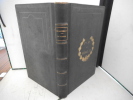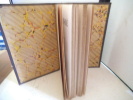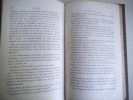-
Type
Any type (2)
Art print (7)
Book (31698)
Disk (1)
Drawings (7)
Engraving (9)
Magazine (125)
Old papers (1)
Photographs (14)
Posters (4)
-
Latest
Last 24h (2)
Last 3 days (4)
Last month (400)
Last week (49)
-
Language
Dutch (1)
English (52)
French (31771)
German (6)
Italian (18)
Portuguese (9)
Spanish (11)
-
Century
16th (15)
17th (56)
18th (213)
19th (1577)
20th (9507)
21st (1698)
-
Countries
Belgium (9478)
Brazil (7)
Canada (108)
China (1)
Côte d'Ivoire (66)
Denmark (218)
France (18882)
Germany (1)
Greece (1)
Italy (37)
Switzerland (3069)
-
Syndicate
ALAC (99)
CLAM (41)
CLAQ (94)
CNE (3)
ILAB (10917)
NVVA (1171)
SLACES (1171)
SLAM (8372)
SNCAO (9)
VIEILLES MAISONS FRANCAISES N°21 - Le château de Virieu (Isère), par B. V. Quelques Demeures d’Ecrivains, par André Maurois, de l’Académie Française (I)Le château de Sury-le-Comtal (Loire),par J. de La Grange-Sury
VIEILLES MAISONS FRANCAISES. JUIL 1964. In-12. Broché. Bon état, Couv. convenable, Dos satisfaisant, Intérieur frais. 103 pages. Nombreuses photos en noir et blanc dans et hors texte.. . . . Classification Dewey : 720-Architecture
Sommaire : Le château de Virieu (Isère), par B. V. Quelques Demeures d’Ecrivains, par André Maurois, de l’Académie Française (I)Le château de Sury-le-Comtal (Loire),par J. de La Grange-Sury Une coordination est nécessaire Lucenier (Saône-et-Loire), par le Marquis de Montmorillo:; Concours des chefs-d’œuvre en péril àla R.T.F.L’Abbaye de Saint-Gilbert-de-Neuf fonts(Allier), par Pierre Lerat Un sauvetage dans le Gers : le châteaude Flamarens, par P. C.Le château de Caradeuc, à Bècherel(Ille-et-Vilaine) Groupements internationaux Chevignes (Saône-et-Loire), par Jacquesd’Welles Diors (Indre), le Musée des Trois Guerres, par Ch. G.-B.Office International des Arts Abbaye de Clermont-le-Genest (Mayenne),par le Chanoine Picquenard Les belles heures d’une vieille Maison française dans une grande demeure,par Micheline de Grandmaison Foire de Paris Le château d’Abbans-Dessus (Doubs) (II),d’après Paul de Fontenay Sauve-t-on réellement le Marais ?En Alsace, « l’opération taupe », parJean-Michel Tuchscherer V. M. F. et les jeunes dans le Finistère . . Dégâts causés par les vols supersoniques Entretien et conservation des bois dans la construction, par Gérard Legrez . .Journée des V.M.F.Activités régionales Carnet des V. M. F.Rubrique Immobilière Ouvrages reçus et Sociétés amies Divers . Classification Dewey : 720-Architecture
La Cathédrale de Strasbourg. Notice historique et archéologique.
P., Longuet, 1925, 1 vol. in-8 br. de 221 pp.
Nombreuses illustrations hors texte.Mention de Nouvelle édition en couverture.Bel exemplaire.
DELAHAYE, H. - DREGE, J.-P. - WILSON, D. - ) - ZEWEN, L.Commencée à être construite au IIIe siècle avant J.-C., la Grande Muraille a une histoire qui se confond avec celle de la Chine. Jamas auparavant des photographes n'avaient eu accès à l'ensemble de l'édifice.
Reference : 14694
La Grande Muraille
PARIS, Armand Colin 1982 - Grand in-8, 22 x 8,50 cms - Reliure toile de l'éditeur avec jaquette illustrée - Nombreuses illustrations et documents NB ou couleurs - 191 pp. - Très propre
- Livraison a domicile (La Poste) ou sur simple demande en Mondial Relay.- ATTENTION: Colis recommandé uniquement sur demande (parcel recommended on request). Si vous désirez un remboursement équivalent au montant de votre achat, en cas de perte détérioration ou spoliation, demandez-nous expressément un envoi en recommandé ( if you wish a repayment equivalent to the amount of your purchase, in case of loss - deterioration or despoliation, ask us expressly for a sending recommended)- Conditions de vente : Les frais de port sont affichés à titre Indicatifs (pour un livre) Nous pouvons être amené à vous contacter pour vous signaler le surcoût du au nopmbre de livres achetés ou du poids de ceux-ci. - Conditions of sale : The shipping costs are displayed as an indication (for one book) We may need to contact you to inform you of the cost of the additional shipping depending on the weight and the number of books- Possibilité d'envoi par Mondial-Relay - Réception en boutique sur rendez-vous. Librairie G. PORCHEROT - SP.Rance - 0681233148
DELAHAYE Hubert, DREGE Jean-Pierre, WENBAO Dai, WILSON Dick, ZEWEN Luo -
Reference : 3930
La Grande Muraille, Armand Colin Éditeur, Paris 5ème, 1982
22x29 cm, pleine reliure toile dorure sur titre premier plat et dos avec jaquette illustrée, 192 pages, très bon état, nombreuses photographies, illustrations, reproductions et cartes en couleurs et N&B, avant-propos de Jacques Gernet, professeur au Collège de France, index, bibliographie, carte et chronologie en fin d'ouvrage, ISBN : 2-200-37045-8
Un journaliste, deux historiens et un documentaliste collaborent pour nous présenter ce chef-d'oeuvre de l'architecture militaire. Un panorama détaillé dessine dans son entier la Muraille et permet de situer avec précision l'emplacement des forts, des palais et des champs de fouilles. Une abondante illustration de photographies récentes et de gravures anciennes évoque en image la vie des populations alentour ; merveilleuse introduction à la connaissance de la civilisation chinoise.
Les Grilles médiévales du centre de la France.. Essai d'inventaire
S.l., 1973 in-8, paginé 97 à 150, ill. in-t., agrafé, sous couverture.
Extrait de la Revue d'Auvergne, tome 87, n°2, 1973. - - VENTE PAR CORRESPONDANCE UNIQUEMENT
Miniatures m di vales. De la librairie de Bourgogne au cabinet des manuscrits de la Biblioth que Royale de Belgique
, Edit par Banque de Paris et des Pays-Bas / Editions de la Connaissance, 1959 Hardcover, 224 pages, Texte en Francais, 310 x 245 mm, jacquette, une bon exemplaire,.
La Science de l'Ingénieur. En 3 volumes : 2 Tomes + 1 Tome d'Atlas.
FAVERIO. 2nde édition. 1832. In-8. Relié demi-cuir. Etat d'usage, Couv. légèrement passée, Dos frotté, Quelques rousseurs. 456 + 464 pages + LVI planches dépliantes de schémas, cartes et plans en noir et blanc hors-texte. Titre, tomaison, filets, roulettes dorés sur le dos cuir noir. Epidermures sur le cuir. Coiffes frottés. Traces d'humidité importantes dans l'Atlas de planches.. . . . Classification Dewey : 720-Architecture
Divisée en 3 parties où l'on traite des chemis, des ponts, des canaux et des aqueducs. Revue et Augmentée par Laguerenne. Aqueduc de Mesuran - Arche St-Edme de Nogent sur Seine construite en 1768 - Aqueduc du Gard - Construction de ponts en bois - Pont Tournant - Construction de Pont en Fer - Pont Pile ... Classification Dewey : 720-Architecture
Manuel de l'architecte et de l'ingénieur, ouvrage utile aux entrepreneurs, conducteurs de travaux, maîtres maçons, charpentiers, contre-maîtres, etc, etc, et en général à toutes les personnes qui s'occupent de constructions
Persan et Cie Paris, Persan et Cie, 1825. In-16 broché de XXXVI + 369 pages. Introduction par M. Edme Ponelle. Persan et Cie. Couverture tachée et rousseurs
Toutes les expéditions sont faites en suivi au-dessus de 25 euros. Expédition quotidienne pour les envois simples, suivis, recommandés ou Colissimo.
New-York. Images mouvantes. Dessins d’Henriette Delalain.
P., Publications du centre 1929 Petit in-4 broché, couverture rempliée, non coupé, 76 pp. 16 compositions hors-texte sous serpente légendée. Très bon exemplaire.
Num. sur velin. Bel envoi de l’auteur à Paul Léon. Bon état d’occasion
Restauration de la flèche de Caudebec, 1883-1186.
1888 Imprimerie de Espérance Cagniard, Rouen, 1888. Un volume in-8 demi chagrin marine à coins, dos à nerfs orné de fleurons dorés, titre doré, double filet doré sur les plats, tête dorée, couverture conservée, 143 pages, héliogravures sous serpentes. Envoi de l'auteur, infime manque à un mors, bel exemplaire.
La librairie est ouverte du mardi au samedi de 9h30 à 12h30 et de 13h30 à 19h00. Commandes par courriel ou téléphone. Envoi rapide, emballage soigné.
Essai sur la véritable origine et sur les vicissitudes de la cathédrale de Coutances.
Caen, Hardel, 1841 in-4, 127 pp., 14 planches dont 1 frontispice, demi-chagrin brun, dos à nerfs (reliure de l'époque). Coupes et coins usés. Rousseurs, parfois fortes. Mouillures en fin d'ouvrage.
Rare édition originale. - - VENTE PAR CORRESPONDANCE UNIQUEMENT
Delamarre, Mariel Jean-Brunhes - Deffontaines, Pierre Cartes de Jacques Bertin -
Reference : 27386
Atlas Aérien - France - Tome II - Bretagne - Val de Loire - Sologne et Berry - Entre Loire et Gironde
PARIS, N.R.F./Editions Gallimard , 1957 - In-4 - Reliure pleine toile sous jaquette illustrée (accroc) - 192 pages , 268 photographies et 3 cartes en noir et blanc - bon exemplaire - Envoi rapide et soigné
- Livraison a domicile (La Poste) ou sur simple demande en Mondial Relay.- ATTENTION: Colis recommandé uniquement sur demande (parcel recommended on request). Si vous désirez un remboursement équivalent au montant de votre achat, en cas de perte détérioration ou spoliation, demandez-nous expressément un envoi en recommandé ( if you wish a repayment equivalent to the amount of your purchase, in case of loss - deterioration or despoliation, ask us expressly for a sending recommended)- Conditions de vente : Les frais de port sont affichés à titre Indicatifs (pour un livre) Nous pouvons être amené à vous contacter pour vous signaler le surcoût du au nopmbre de livres achetés ou du poids de ceux-ci. - Conditions of sale : The shipping costs are displayed as an indication (for one book) We may need to contact you to inform you of the cost of the additional shipping depending on the weight and the number of books- Possibilité d'envoi par Mondial-Relay - Réception en boutique sur rendez-vous. Librairie G. PORCHEROT - SP.Rance - 0681233148
VIEILLES MAISONS FRANCAISES N°183 - Avant-propos - Jean DelaneauLes châteaux témoins de l’Histoire Le jardin de la France - Jean Cier. Châteaux de courre - Dr Marc Jacquet. Nobles demeures - François Benjamin.Elle fait naître les vitraux d’art
VIEILLES MAISONS FRANCAISES. JUIL 2000. In-12. Broché. Bon état, Couv. convenable, Dos satisfaisant, Intérieur frais. 107 pages. Nombreuses photos en couleur et noir et blanc dans et hors texte.. . . . Classification Dewey : 720-Architecture
Sommaire : Avant-propos - Jean DelaneauLes châteaux témoins de l’Histoire Le jardin de la France - Jean Cier. Châteaux de courre - Dr Marc Jacquet. Nobles demeures - François Benjamin.Elle fait naître les vitraux d’art .Jean-Claude Bertin.Un nouveau regard sur les jardins du château du TouvetL’affaire de la ZAC de Fontainebleau Pierre de Lagarde.Le Quercy blanc en péril..Bernard de Maismont.Pèlerinage littéraire-Georges Poisson et Paul Métadier.Un rural original - Colette Huet.Balade dans les villages-Marie-Claire Colignon.Côté vignobles - Jacques Puisais.Animations..Livres .Patrimoine ..Expositions..Fiscalité..L’EuropeFascinante Gatienne - Arnaud de Saint-Jouan.Louange et pouvoir - Anne Debal-Morche, Martine Lainé et Valérie Mauret-Cribellier.Villes d’art au bord de l’eau-Thierry Casters, Jacques Lablancherie et Marie-Hellene Legal-Bruckert.Détour à Tours - Alain Irlandes.•La ville de Richelieu - Jean-Claude Aubineau.La soie dans tous ses étatsPalmarès des prix nationaux VMF 2000BrèvesJournées du patrimoine 2000 Friends of VMF.VMF Jeunes.Activités départementalesListe des déléguésListe des délégués adjoints - Carnet ..Annonces Classification Dewey : 720-Architecture
La Tunisie
In 8 reliure éditeur demi chagrin marron foncé, plats percaline armes du lycée de Versailles au premier plat avec filets à froid en encadrement. Faux titre, titre, 268 pages, carte dépliante en couleurs, en fin de volume. Paris ancienne Librairie Germer Baillière & Cie. Félix Alcan éditeur 1887. Rousseurs .Edition originale
DE LA RECONSTRUCTION DU MARCHE AUX SOULIERS,
Anvers, Nederlandsche Boekhandel, 1915 Broche, couverture papier illustree rouge et noir, 160 x 235mm., 22pp., illustration n/b.
Bon etat.
De la reconstruction du marché aux souliers
Anvers, Nederlandsche Boekhandel 1915 22pp.illustré de 2 Plans, 24cm., br.orig., non coupé, qqs. rousseurs, bon état, B88884
Souvenirs de la vie et des ouvrages de F. J. Delannoy, architecte.
1839 Paris, Imprimerie de Everat et Cie, 1839; petit in folio de 24pp. de texte et 26 planches d'illustrations gravées au traite dont plusieurs à double page. Plein cartonnage éditeur brun, titre doré au dos lisse sur étiquette de maroquin rouge.
L'architecte François- Jacques Delannoy (Paris, 1755 - Sèvres 1835), participa aux projets de la Banque de France et de la Galerie Vivienne. - Travaille pour le Théâtre-Italien en 1825. Rousseurs, cartonnage frotté, dos insolé, manque la coiffe supérieure.( Reu-CO1)
Eglises de Suisse. I. Du roman au gothique.
Neuchâtel, Avanti 1970, 260x175mm, 136pages, en feuilles sous couverture de l’éditeur.Exemplaire hors commerce tiré à 25 exemplaires n° 17.
photos couleurs, nombreux dessins, Pour un paiement via PayPal, veuillez nous en faire la demande et nous vous enverrons une facture PayPal
Eglises De Suisse, I, Du Roman Au Gothique, Éditions Avanti, Neufchâtel, 1970
1724 17x24 cm, 136 pages, bon état, dos décollé, pleine reliure marron simili plein cuir, pièces de titre et caissons dorés, beau tranchefile, pagination irréprochable, belle illustration sur les contre-plats et gardes volantes, nombreux dessins et figures en N&B de Reynald Hasler, nombreuses photographies (magnifiques) en couleurs de l'auteur, encollées dans le texte, bibliographie sommaire et index en fin d'ouvrage -
Les églises sont des témoins visibles du passé. Elles reflètent la vision chrétienne du monde qui a marqué lhistoire des hommes. Depuis toujours, lhomme tente de représenter ce quil ne comprend pas et ne peut saisir. Larchitecture sacrée cherche à créer un lien avec linvisible, à se rapprocher de Dieu. Lénergie déployée par les hommes pour y parvenir est à la mesure de la piété qui les animait, et de la façon dont ils envisageaient la vie au fil des époques et des siècles, du roman au gothique. Après avoir écrit sur l'artisanat persan et l'Afghanistan, Alain Delapraz, photographe, cinéaste, écrivain et voyageur, signe, malgré sa grande modestie, un livre très inspiré et respectueux.
Essai sur les girouettes, épis, crêtes et autres décorations des anciens combles et pignons (pour faire suite à l'histoire des habitations au moyen-age)
Paris/ Rouen, Derache & Dumoulin/ Lebrument 1846 xx + 86 [4bl.] pp.+ 8 planches hors-texte gravées par Polyclès Langlois, 23cm., br.orig. (petits manques de papier), quelques rousseurs, bon exemplaire, rare, S79628
Description historique des maisons de Rouen, les plus remarquables par leur décoration extérieure et par leur ancienneté ; dans laquelle on a fait entrer les édifices civils et religieux devenus propriétés particulières.
1821 Firmin-Didot, Paris, 1821 et Nicétas Périaux, Rouen, 1841. 2 tomes reliés en un volume in-8, demi basane violine, dos lisse orné de simples filets dorés et de dentelles en queue, faux titre et avis au relieur, frontispice, page de titre, 260 pages, 17 planches ; faux titre et avis au relieur, frontispice, page de titre, VIpp, 290pp. Bel exemplaire malgré un léger accident au mors inférieur.
La librairie est ouverte du mardi au samedi de 9h30 à 12h30 et de 13h30 à 19h00. Commandes par courriel ou téléphone. Envoi rapide, emballage soigné.
VIEILLES MAISONS FRANCAISES N°49 - Le château de Clermont ( Loire-Atlantique), par Jean de la ROBIE.Congés de la Rédaction .Le dessin de Don .Etude et sauvegarde de la Forteresse de Blanquefort (Gironde), par AlainTRIDANT, Gilles ROSSI
VIEILLES MAISONS FRANCAISES. JUIL 1971. In-12. Broché. Bon état, Couv. convenable, Dos satisfaisant, Intérieur frais. 145 pages. Nombreuses photos en noir et blanc dans et hors texte.. . . . Classification Dewey : 720-Architecture
Sommaire : Le château de Clermont ( Loire-Atlantique), par Jean de la ROBIE.Congés de la Rédaction .Le dessin de Don .Etude et sauvegarde de la Forteresse de Blanquefort (Gironde), par AlainTRIDANT, Gilles ROSSI, Patrick GROSJEAN Tourreau (Vaucluse), par Claude de BOISANGER La Truelle d'Hippocrate ..Le château de Hautefort (Dordogne), par la Baronne de BASTARD .Récents travaux de restauration au château d'Esclignac (Gers), par YvanSERAPHIN Du nouveau au château de Breteuil (Yvelines), par Henri de BRETEUIL Notre concours des erreurs Le château du Logis (Orne), par CHALUFOUR ..Saint-Martin de la Garrigue (Hérault), par J. BERGASSE et J. FABRE deMORLHON ..Le Club du Vieux Manoir au Marais, par Monique DINE La Chronique d'Europa Nostra, par le Marquis de AMODIO ..Offre pour deux grands châteaux Protection des Monuments Historiques en cas de guerre, par le Marquis deAMODIO .La page de l'I.B.I. par le Marquis de AMODIO Rubrique juridique et fiscale (Revenus exceptionnels ou différés), parB. DUMAS de RAULY .Assemblée générale .Journée des « Vieilles Maisons Françaises » .Activités régionales Le carnet des V.M.F.. .La critique de Jacques de RICAUMONT, ouvrages reçus et sociétés amiesRubrique immobilière, divers .. Classification Dewey : 720-Architecture
Rome.
Souvenirs religieux, historiques, artistiques de l’expédition française de 1849 et 1850. Par Madame de La ROCHERE. In 8 demi cuir à nerfs, titre et caissons dorés, filets à froid. Plats percaline chagrinée, quadruple filet doré en en encadrement. Faux –titre, frontispice gravé sur acier, vue générale de Rome, sous serpente, titre, 500 pages, ranches dorées, rousseurs sur serpente de la gravure en regard de page 259. 7 planches hors-texte gravées sur acier, sous serpentes, d’après ROUARGUE par FRANCAIS er GIRARDET. Des rousseurs en marges, des cahiers légèrement décalés, charnière supérieure droite restaurée. Tour A. MAME & Cie 1854
une petite tache circulaire, apparaît sur certaines photos à fond clair, elle est due à un problème d'objectif de mon appareil photo
[Crété] - DELARUE-NOUVELLIERE ; Groupement des Sociétés Coopératives approuvées de Reconstruction des Eglises dévastées de France.
Reference : 41834
(1921)
Emprunt pour la Reconstruction des Eglises dévastées. 6% net d'Impôts présents et futurs, garanti par des annuités de l'Etat. [ Affiche. Edition originale ]
1 affiche format 745 x 1145 mm, Crété, Paris, s.d. [ 1921 ]
Etat très satisfaisant (pliures, 2 petits accrocs marginaux sans manque) Paillard, n°376
L'architecture religieuse en France à l'époque Gothique Tomes I et II(2 volumes)- Ouvrage posthume
Auguste Picard. 1926-1927. In-4. Relié demi-cuir. Etat passable, Coins frottés, Dos frotté, Papier jauni. 544+604 pages. Nombreux clichés, plans, illustrations en noir et blanc, in ethors texte. Rares rousseurs et salissures. Plats et contre-plats jaspés.Signets conservés. Dos à 8 nerfs frottés.. . . . Classification Dewey : 720-Architecture
Publiés par Marcel Aubert. Classification Dewey : 720-Architecture
 Write to the booksellers
Write to the booksellers





















